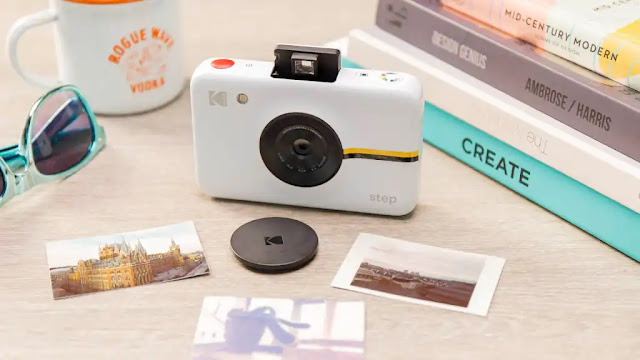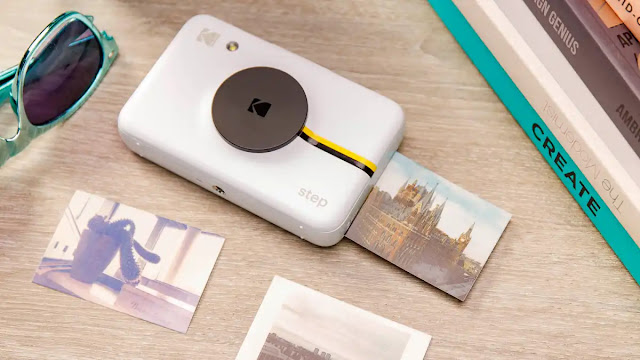A small Step, but no giant leap.
Pros
- Multiple shooting modes
- Compact, lightweight design
- Option to save shots to microSD
Cons
- Disappointing photo quality
Our Verdict
Instant cameras were once the domain of Polaroid, and now are dominated by Fujifilm’s Instax, but that’s not the only game in town – and historic camera rival Kodak has its own offering.
Unlike Instax, the Kodak Step camera doesn’t shoot on true film. Instead, this is a simple digital camera that prints to Zink sheets – an inkless form of printing that produces compact, sticky-backed prints.
Design And Build
- Simple plastic design
- Available in white or black
- Magnetic lens cover
The Step is a simple, compact camera, and this is one of its biggest strengths. Thanks to the choice to print to Zink, this is smaller than just about any Instax camera on offer, making it super portable.
Unlike the similar Step printer, this doesn’t come in a range of colours, and instead you’re limited to a choice of white or black for the matt plastic build.
Other additions are the option to attach a wrist strap to keep the camera safe, and even a tripod screw mount on the bottom, though I doubt many will get a lot of use out of that.
One attractive touch is the pop-up flash, which springs out of the body when you turn the camera on. Just as conveniently, pushing this back down will in turn switch the Step off again.
Camera Quality
- Colour, sepia, and monochrome options
- Small prints
- Uneven exposure
As mentioned above, the Step lets you print shots in three colour modes: full colour, washed out sepia, or black-and-white. You also get the option to add a white frame around shots, in a nod to the classic Polaroid aesthetic.
The options are welcome, but actual print quality remains limited. This is more of a Zink problem than a Kodak Step problem, and prints here have familiar problems with colour banding and limited detail, not helped by how small the prints themselves are.
It’s also worth noting that the flash is automatic, and entirely out of your control. It’ll fire when scenes are sufficiently dark, but you can’t choose to activate it at other times, or deactivate it when you prefer.
Prints are quick at least – it takes less than a minute to print a shot, and unlike Instax shots you don’t have to wait longer for photos to fully develop. Loading film is also a doddle, and less than a minute’s work.
Battery Life
- 40 prints per charge
- Charges over Micro-USB
Kodak says that the Step camera can take a full 40 photos on a full charge, i.e. four full packs of Zink prints.
I haven’t quite taken that many shots, but didn’t see the camera run out of battery any faster than that. Battery will drain on standby too though, so if you go a long time between uses you may find it needs a quick charge to get going again.
Price And Availability
The Kodak Step camera is available now worldwide, and will cost you $70/£70/€80.
That only gets you the camera itself, so you’ll have to buy prints separately. These typically go for $25 for 50 prints in the US, or £17/€15 for a pack of 20 in Europe. That might sound like a lot, but it is still cheaper than the per-sheet price of Instax.
That means that in the long run this is a touch cheaper than the otherwise similarly priced Instax Mini 11, though we tend to prefer the photo quality from that camera.
The Kodak Step is also cheaper than the Polaroid Snap, an essentially identical Zink camera with Polaroid branding and a slightly higher price.
Check out our ranking of the best instant cameras for more alternatives.
Verdict
Zink camera are much of a muchness, and indeed the Kodak Step is essentially a re-package of the Polaroid Snap under a different name.
Like other Zink cameras, this is let down a little by its photo and print quality, which can’t match Instax rivals.
It’s more compact and portable than those cameras though, and with a few easy-to-access photo modes and the option to save digital photos as well as print them, this is a versatile instant camera option for those on a budget.













%20Review.webp)







0 comments:
Post a Comment